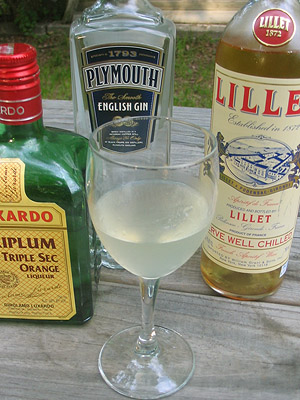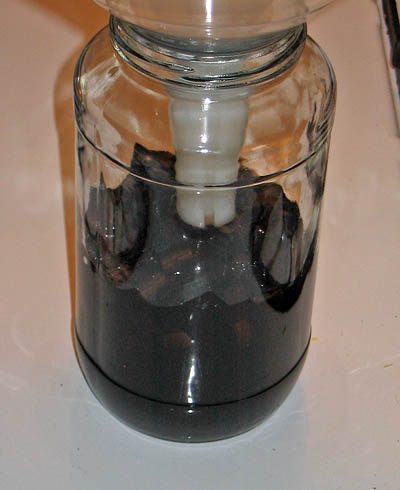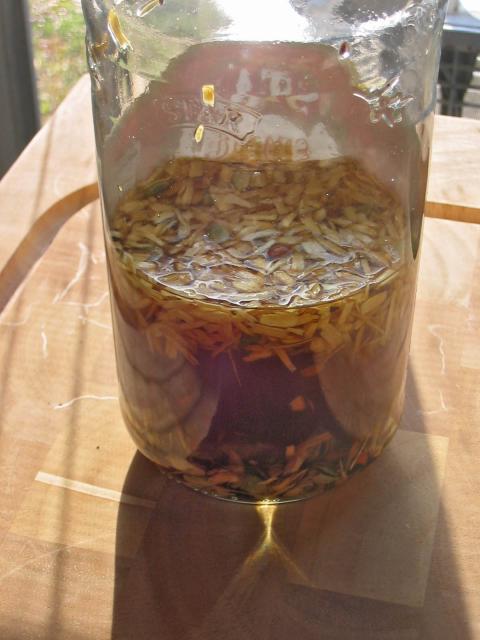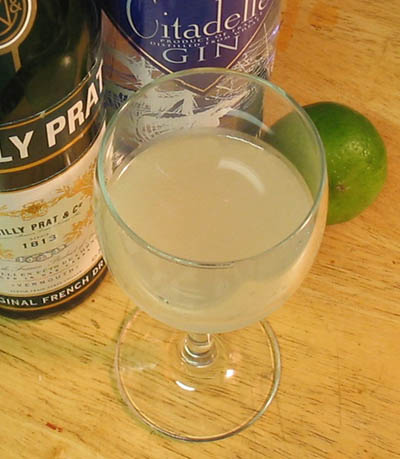-
Posts
178 -
Joined
-
Last visited
Content Type
Profiles
Forums
Store
Help Articles
Posts posted by David Santucci
-
-
Anyone know any other interesting products that can be had in the desolate wastes (liquor selection-wise at least) of North Carolina?
Frankly, there isn't much, although A Southern Season does regularly stock Vya Vermouth. Kroger has a fairly decent selection of vermouths and quinquinas: Noilly, Cinzano, Lillet, Dubonnet. I've never seen Carpano Antica or Punt e Mes, or Byrrh, Suze, etc. anywhere. Bitters, too, are simply not available. A Southern Season carries Underburg, but not Regan's, Peychaud's, Bitter Truth, or any of that. Though, I have noticed that the ABC stores now seem to be carrying Unicum, which is one of my favorites (try it in a Manhattan). But, of course, no Maraschino, Chartreuse or Kirsch, and a pretty crappy selection of Rum, sadly.
For bitters and wines, at least you can turn to the internet. For booze, well, it's head for the border!
-
Since eje seems to have skipped this one, I thought I might as well:

Campden Cocktail
1/2 Dry Gin (1 1/2 oz. Pymouth)
1/4 Cointreau (3/4 oz. Luxardo)
1/4 Kina Lillet (3/4 oz. Lillet Blanc)
Shake well (stir) and strain into a cocktail glass.
It's pretty easy to see how this one is going to be just from reading the recipe -- sweet. Nonetheless I gave it a whirl with the recommended proportions. It's actually quite a pleasant combination of flavors. I think the light touch of the Plymouth works well here. But it is sweeet -- way too sweet for my taste.
To fix this one, I would recommend something more like 3-4 parts Gin, 3 parts Lillet, 1 part Cointreau. In these proportions the flavors of the Lillet are really allowed to shine. Resist the urge to add bitters -- I tried a little sample with Regan's orange and it was like a rhinoceros in the china shop. This a a summery, apéritif-like cocktail, and quite pleasant at that.
-
Since we're in the business of learning about the distinctions between different liqueurs, here's one I've often wondered: How does anisette compare to pastis? I know pastis is supposed to be more herbal, but when I take a sip of Pernod, I'm mostly tasting anise. How does the anisette taste, when you taste them side-by-side?
-
I've often wondered what was the deal with the cheap "Kirschwasser". It is generally a lot higher-proof than other cheap cordials. Of course, I've always assumed the worst. Thanks for confirming my suspicions.
So here's a question: what cheap cordials that you actually like?
I am a big fan of Jacquin's Apricot Brandy. It is absolutely delicious in cocktails. One I have been enjoying a lot lately is the Cuban (the variation with white rum, apricot brandy and lime juice). I know Brizard Apry is supposed to be the best in this category, and I haven't had occasion to compare the two, but the Jacquin's is pretty good (and available for sale in North Carolina).
-
This is pure speculation, but it seems to me that the preference for stirring over shaking Juleps is aesthetic: It's just a bit more visually interesting when the frost on the outside of the glass goes up to the top of the where the liquid/ice is and stops.
Splificator, why do you prefer to fish out the mint and garnish with a fresh sprig? Is this an aesthetics thing or an aromatics thing?
-
CocktailDB lists Dubonnet as a Byrrh substitute -- how would you compare the two?
-
Just put the ice in and whack the bejeezus out of it.
With what do you whack it?
-
COOLERS
A Cooler is essentially a Horse's Neck with a Kick (see page 277), although there are also Prohibition Coolers made with non-alcoholic ingredients. So far as I have been able to ascertain, the original was the Remsen Cooler and, while most modern recipe books indicate gin for the Remsen Cooler, this is incorrect. This Cooler derived its name from the fact that it was made with Remsen Scotch whiskey, a brand no longer seen, at least in this country.
The Cooler is served in a Collins glass decorated with the skin of a whole lemon or orange cut in a continuous spiral and hung over the edge of the glass, exactly as in the Horse's Neck. Sometimes both a lemon peel and an orange peel are used for decoration.
Whereas the Horse's Neck is made with ginger ale, the original Remsen Cooletr was made with club soda. Today some Coolers are made with charged water and some with ginger ale. There are also Coolers made with other carbonated beverages, at least one or two made with cider, and some modern recipes even stoop to prescribing plain water. The Cooler should be very dry, but sugar can be used if desired and perhaps the best advice here is "sweeten according to taste." If you want the drink to be thirst-quenching, refreshing, and satisfying, however, you must keep it definitely on the dry side. The base of the Cooler may be a spirituous liquor, a wine, a liqueur, or even a fruit syrup. With sweet wines or liqueurs it is usually advisable to use a few dashes of lime or lemon juice, but this is optional. It is also optional whether or not to use bitters and how much.
With the above principles well in mind you should be able to "roll your own" Coolers with whatever ingredients may be at hand and of any type and strength to suit any taste from that of an Andy Volstead to that of the Old Soak. However, the following are offered as specimens:
REMSEN COOLER (The original Cooler) Decorate a Tom Collins glass with a lemon peel as above directed and place 3 or 4 large ice cubes in the glass. Add 2 to 3 ounces Scotch whisky and fill the glass with charged water. Stir quickly with bar spoon and serve.
APPLEJACK COOLER or BRANDY COOLER or GIN COOLER or RUM COOLER or WHISKY COOLER Except for the liquor used, these are made exactly like the Remsen Cooler. Ginger ale maybe substituted for the charged water if desired.
The Rum Cooler, when made with Jamaica rum, is sometimes calleda BLACKSTONE COOLER.
STONE FENCE or STONEWALL JACKSON An Applejack Cooler with hard cider in placeof the carbonated beverage.
BOSTON COOLER A Rum Cooler with the addition of 1 teaspoonful sugar syrup and the juice of half a lemon.
MOONLIGHT COOLER or HARVARD COOLER Made like a Boston Cooler but with applejack instead of rum.
LONG TOM COOLER Made like a Boston Cooler but Old Tom gin instead of rum.
WINE COOLERS Use any wine desired and make the same as other Coolers except that with the light, unfortified wines, a larger quantity should be used than in the case of spirituous liquors. With very sweet wines, such as sauterne and port, add 1 teaspoonful lemon juice. With very dry wines, such as Rhine wines, a teaspoonful of sugar syrup or of a liqueur such as maraschino or curaçao or may be added.
A Claret Cooler plus a few dashes of rum is sometimes called a MANHATTAN COOLER.
COUNTRY CLUB COOLER or VERMOUTH COOLER Use 1 ounce grenadine, 3 ounces French vermouth, and charged water. Italian vermouth may also be used, in which case omit the grenadine and add 1 teaspoonful lemon juice.
DUBONNET COOLER or BYRRH COOLER Italian Vermouth Cooler exceptfor the base wine.
And now there are a few PROHIBITION COOLERS for your teetotaler friends:
MINT COOLER Crush one or two sprigs of mint with 1 or 2 teaspoonfuls sugar in the bottom of the glass, add the ice, decorate with the lemon peel, and fill glass with ginger ale.
RAIL SPLITTER One ounce sugar syrup, juice of 1 medium-sized lemon. Fill up with ginger ale.
SARATOGA COOLER Ginger ale and sarsaparilla, half and half.
The Rail Splitter plus a few dashes of Angostura is also sometimes called a Saratoga.
LONE TREE COOLER Juice of 1 lemon and ½ orange with 1 ounce grenadine. Fill up with charged water.
-
Try 2-4 parts Cruzan Single Barrel to 1 Grand Marnier plus a dash of Angostura bitters. I've only made it with Grangala, but I guess it will work with the Grand Marnier.
-
You won't need too much in the way of equipment, but you will want a cocktail strainer, a shaker, and the equipment to juice limes, lemons and orages, and measure 1/4, 1/2, 3/4, 1 and 1 1/2 ounces. You'll want to get some bitters too.
The Martini and the Manhattan are classics for a reason and a fine place to start. Plus, vermouth is cheap and readily available. From there you can try the Affinity, the Bronx, the Delmonico, etc. Also, a favorite of mine of late, the Hong Kong Cocktail.
When you're ready to try something a little more fancy, a truly great cocktail that is fun to make and will impress your friends is Dale DeGroff's Millenium Cocktail:
1 1/2 oz. Cognac
1 1/2 oz. pineapple juice
1 oz. Orange Curacao
dash Angostura bitters
garnish with a flamed orange peel and fresh grated nutmeg.
This one has you shooting flames out of a piece of orange peel and onto the top of your drink -- woo hoo!
-
How fine does the Swing-a-Way crush the ice? Pencil eraser is definately not fine enough. The goal here is powdery-fine. The Cuisinart gets it pretty fine -- a little finer than the typical Sno-Cone, though not quite as fine as a shaved ice. Embury and others recommend putting ice into a towel and pounding away until snow results. I've tried a few times, but without success. Could be my choice of towel/bag and/or mallet/frying pan.
My method for the Mint Julep:
1. Bruise a few mint leaves in the bottom of an Old Fashioned glass.
2. Add a little bit of simple syrup.
3. Pack the glass full with powdery-fine ice.
4. Pour Bourbon over same, leaving just enogh room at the top to vigorously stir.
5. Vigorously stir for a good long time.
As you can see, the amount of simple syrup you need will vary with the size of your glass. In my glasses, these definately end up being big, stiff drinks. Getting only six drinks out of a bottle is not unheard-of. If you're not feeling the alcohol after one, you may have sprung a leak. The Kentucky Derby only lasts two minutes, so you want your drink to take effect quick.
-
As far as making finely-crushed ice, I have had pretty good luck doing this in the food processor. And now that I've got the nice KitchenAid blender, I bet I could get some pretty powdery ice to come out of it too. I haven't had much luck with the bag and mallet/frying pan method, however. What is the preferred method/equipment there?
-
I have to report that in joining the 'Stomping Through the Savoy' team, I'm also taking one for the team.
I have to admit that I have secretly suspected that eje had decided to go back to the recipe he missed because of the dismal-looking drinks ahead, like the Brunelle. How about a Buds Special anyone -- the only thing that sounds worse than the name is the recipe. Then, (after the Bull-Dog, aka Gin n' Juice), to add injury to insult -- the Bunny Hug!
I think you could salvage the Brunelle by making it a tall drink -- top it off with soda and adjust the sweetness accordingly. Even better, add to that some almond extract or Amaretto and perhaps a dash of bitters.
-
I liked this one a lot, actually. It's fairly subtle, as cocktails go. Whisky, herby, orange. Sophisticated, I'd say.
Welcome back stateside eje. I'm curious to hear what new ingredients you picked up while you were in the UK.
I too have become fond of the Brainstorm. Adding more Benedictine and a dash of rum was quite nice too. I have also had success adding a dash of Maraschino.
-
I am fond of the design that cuts at 90 degrees to the handle. As eje and Alchemist suggested, cut the twist right over the drink--and watch the oils fly. In my hands this is absolutely the best way to get the flavor of the zest into a drink. Dropping the resulting twist in is basically just for visual effect. And, personally, I think the long thin twists look a bit prettier than the wide ones. The only downside is that channel knives tend to be bit aggressive (i.e., they cut deep), so they don't work well with thin-skinned citrus. I keep thick-skinned lemons around for cutting twists and thin-skinned ones for juice.
-
According to Dave Wondrich's "Esquire Drinks", there are two types of Curacaos: Orange and White. Triple Sec (which is not dry at all!) is a White Curacao, as is Cointreau (which is, also, a Triple Sec). The Marie Brizard, on the other hand, is an Orange Curacao, as is Grand Marnier. And the Senior Curacao of Curacao, it appears, is a White Curacao, which is also available colored orange (and blue, green and red).
The original liqueur is clear in color, but it is also available in four (4) other colors: blue, red, mandarine (orange) and green.These colors are available for cocktail purposes (please refer to the RECIPES SECTION of this website).
The taste is exactly the same. Our liqueur contains 31% alcohol (by volume).
-
However, I thought it a fine opportunity to gather a few of the examples of Orange Liqueur I seem to have accumulated and do a little comparison.
Very interesting. What I am curious about is, how does M. Brizard Orange Curacao compare to other brandy-based Orange Liqueurs, such as Grand Marnier or Grangala. Anybody done that comparison?
-
I would recommend the Zazerac. The CocktailDB recipe has a little different proportions from the Savoy recipe
1/6 Bacardi Rum
1/6 Anisette
1/6 Gomme Syrup
1/3 Canadian Club Whisky
1 Dash Angostura Bitters
1 Dash Orange Bitters
3 Dashes Absinthe
which is also notable for not adding up to unity! I used Rye rather than Canadian and Pastis rather than Anisette/Absinthe.
Another is a tall drink I made up, with an Anise/Lemon/Almond flavor combination that I found quite nice. The proportions I can't say exactly, but I made it very Pastis-heavy, something like:
1 1/2 oz. Pastis
1/4 oz. Lemon Juice
1/4 oz. Amaretto
Dash Orange Bitters
Top with soda water.
For anise-lovers only and godawful before adding the soda.
-
So the Abbott's Bitters replica got done steeping today. boiled the solids in water and added that and some brown sugar. Next step, back into the jar with toasted oak chips:

And, I finally got my Catechu and Malva flowers from Alchemy Works, so I started up the batch of the Boker's Bitters replica:

The Catechu is interesting stuff. Looks like little black rocks and smells smoky, kinda like Lapsang souchong tea.
-
The only cocktails which are consistently volume based are the ones which use measures like "glasses" or "wine glasses".
Allowing that these "glasses" or "wine glasses" are something like 2 oz, I have found the portion size is probably somewhere closer to 2oz than 3oz. That is to say, when I cut the 6 person recipe in half, I end up with 2 large-ish or 3 smallish cocktails.
To me a "wineglass" sounds more like 4 oz. In fact, that's how it's marked on my Mix N Measure mixing glass. Has this changed over the years?
-

Unicum bitters are really good in a Manhattan!
We did a little taste test the other night. A bitters showdown, Manhattan-style. The recipe was 4 parts Elmer T. Lee Single Barrel Bourbon, 1 part Cinzano Rosso Vermouth and 1 dash (3 drops) of Angostura, Peychaud's, Unicum or Regan's Orange Bitters.
On last place, we were unanimous. The Orange Bitters, which are so good in so many drinks, were bad in this. That has been my experience with them: While they have rescued many a drink, or elevated them from good to great, with some drinks they clash horribly and the result is -- not so good.
For second and third places, we were divided. I preferred Angostura to Peychaud's, but half the panel had them coming in the other way around. Both were good though.
The winner, however, was unanimous again. At least in this Manhattan recipe, everyone agreed -- the Unicum was tops.
-
Haven't quite decided what I think of the Boodles.
It was on sale, so I figured I had little to lose. Flavor-wise it seems most similar to Plymouth Gin. Much lighter, though.
The other night I tried it in my usual Martini (2 oz Gin, 1/2 oz Vermouth, dash orange bitters). To me the flavor of the Noilly Prat Dry Vermouth was really the dominant element in the cocktail. It also really seemed to call out for an olive, rather than my usual lemon twist.
I am a fan of the Boodles. And I am 100% in agreement that it just begs for an olive in a Martini.
-

Bronx Terracl (Terrace) Cocktail
2/3 Gin
1/3 French Vermouth
The Juice of 1/2 Lime
Shake well and strain into cocktail glass
I think there might be more than one mistake in this recipe. As it stands, it is awful, however this is a cocktail with potential. Add a dash of sugar syrup, and suddenly the potential of the Gin-Vermouth-Lime combination is unlocked. The CocktailDB recipe for this one calls for sugar too. Even better, add more Vermouth and a splash of bitters, à la the Hong Kong Cocktail. I ended up using 1 oz. Gin, 1 oz. French Vermouth, 1/2 oz. lime juice, 2 tsp. simple syrup and 1 dash Regan's Orange Bitters -- delicious!
-
One I made that was particularly successful was Pineapple-infused Vodka and Tonic.
Tonic need not be limited to Gin n' and Vodka n' drinks. Believe it or not, Tequila n' Tonic is really quite good. I've never tried Rum n' Tonic, but I don't see why you couldnt build a good drink there.
For experimenting, I would try to build on the Something n' Tonic theme. Add a dash of something other than lime juice -- a cordial, either fruit or herbal, an aromatic wine, another type of fruit juice, try garnishing with other fruits or herbs, try adding bitters, orange flower water, etc.



Stomping Through the "Savoy" (2006–2007)
in Spirits & Cocktails
Posted
There are surely many good drinks that could be made with these ingredients, in varying proportions, with and without bitters. I am curious to try Lillet in place of Dry Vermouth in the Hong Kong Cocktail, perhaps reducing the sugar a bit.
What I liked about the Campden was how the delicate-fruity-floral flavors played together. Going to 4:1 Gin to Lillet would change the drink a lot. As I said above, I actually liked it with a little more Lillet. In any case, drop the amount of Triple Sec and this is a drink worth experimenting with.
Pointing up Lillet by adding Cinchona bark, now that sounds interesting. I am no fan of the Vesper, at least not the incarnations I have tried so far. My wife described it as a "girly Martini", which sounds about right to me.